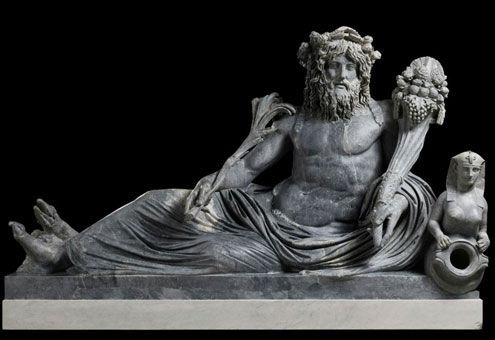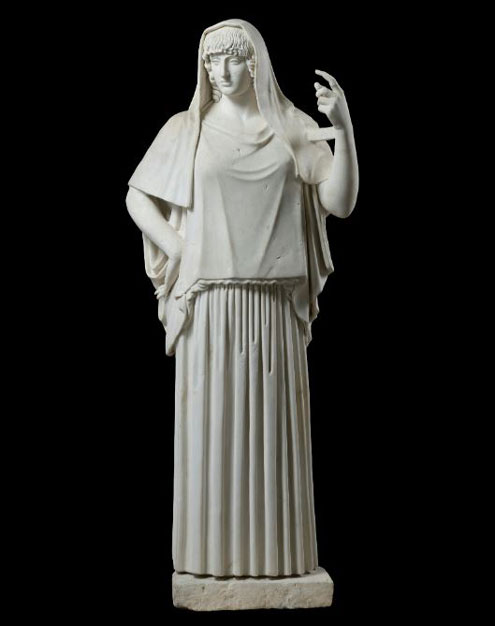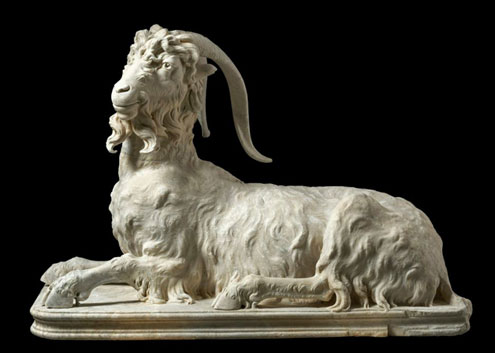The Kimbell is one of only two US venues to host fifty-eight masterpieces from the historic and celebrated collection.
Exhibit ends January 25, 2026
Fort Worth, Texas -- The Kimbell Art Museum will present the special exhibition Myth and Marble: Ancient Roman Sculpture from the Torlonia Collection from September 14, 2025, through January 25, 2026, in the Renzo Piano Pavilion. This exhibition brings to North America for the first time a selection of fifty-eight rarely seen masterpieces from the world’s most important private collection of Roman sculpture.

“The opportunity to bring large-scale works of ancient Roman sculpture to the American public is extremely rare, and we at the Kimbell are grateful to Fondazione Torlonia for creating this once-in-a-lifetime experience,” said Eric Lee, director of the Kimbell Art Museum. “This is the first exhibition of ancient Roman sculpture in the Kimbell’s fifty-three-year history and is all the more exciting because the legendary Torlonia Collection has been largely unseen for the last seventy years.”
Established during the course of the nineteenth century by the Franco-Italian banker Prince Giovanni Torlonia (1754–1829) and his son Prince Alessandro (1800–1886), the Torlonia Collection was handed down over generations, eventually growing into the largest private collection of ancient Roman sculptures. This veritable “collection of collections” was assembled through acquisitions from prominent collections of Roman patrician families and from excavations undertaken on the family’s own estates throughout Italy.
By 1876, Prince Alessandro Torlonia created a museum to house and exhibit the family’s impressive holdings of ancient marbles. The Museo Torlonia was open to small groups until its closure at the onset of World War II. During this closure, Fondazione Torlonia was created at the behest of Prince Alessandro Torlonia (1925–2017) for the continued study and conservation of both the collection and the Villa Albani Torlonia, a monumental complex and one of the highest expressions of eighteenth-century taste.
The sculptures remained largely unseen by the public until Fondazione Torlonia’s first exhibition, at the Musei Capitolini in Rome in 2020. Myth and Marble comes to North America after a recent exhibition of the Torlonia Collection drew unprecedented audiences at the Louvre in Paris.

The works on view at the Kimbell were made between the late fifth century BC and the early fourth century AD, with most dating to the High Imperial period (first–second centuries AD). Visitors will see examples of the most emblematic genres of ancient marble sculpture, including large-scale figures of gods, goddesses, and mythic heroes, vivid portraits of emperors and their families, and magnificent funerary monuments. Half of the sculptures have been newly cleaned, conserved, and studied specifically for this North American presentation.
The exhibition is organized thematically into six sections. Upon entering the Kimbell’s special exhibition galleries, visitors will first encounter three Icons of the Torlonia Collection, including the mid-first-century BC Portrait of a Young Woman, known as the Maiden of Vulci. This is among the earlier and best-known works in the Torlonia Collection, providing a singular representation of Roman female portraiture from the early Augustan era. This and other portraits on view convey the striking naturalism that is a hallmark of ancient Roman sculpture and that viewers will come to appreciate throughout the exhibition.
Next, Ideal Bodies and Model Behavior introduces visitors to depictions of myriad deities from the broader Roman world. This section illustrates how, as it expanded, the Roman Empire increasingly embraced aspects of Greek culture, both in its mythology and its visual language, cementing a shared Greco-Roman cultural heritage. The Statue of a Goddess, known as the Hestia Giustiniani, one of the most important works in the collection, is also one of the very few Roman versions of the classical Greek “severe” style in existence and is the largest and most intact sculpture of its type.

Strategies of Succession displays second-century AD emperors and their imperial families, including a remarkable selection of female portraits. These stunningly realistic portrait sculptures, the likes of which would have permeated public and private spaces in the ancient world, functioned much as mass media does today. Visitors will recognize the names of rulers such as Trajan, Hadrian, Marcus Aurelius, Commodus, and Septimius Severus, whose marble busts at once convey their likenesses, deliver overt political propaganda, and communicate subtle messages of power, authority, and identity.
Not a single work on view in Myth and Marble looks today as it did when it left the ancient artist’s workshop, whether through the wear and tear of time or by the hands of generations of art restorers. Restoration and Reconstruction spotlights sculptures that have been altered over the centuries—sometimes into nearly new works altogether—reflecting how collectors from the Renaissance through the nineteenth century preferred unfragmented objects to decorate their villas and estates. Intact portrait heads were regularly placed on newly carved busts in the past, and sometimes unrelated elements were assembled into wholly new works of art. The Rondanini-Type Medusa on a Trapezophoros (Table Leg) with a Griffin’s Head, for instance, was created through the assembly of two otherwise distinct, ancient sculptural fragments: a Medusa head joined to a Griffin-headed table leg. Sometimes great artists were engaged to update or perfect ancient fragments. For example, a mundane sculpture of a reclining ram was entirely transformed, made glorious with the addition of an exuberant head carved by the famed Baroque sculptor Gian Lorenzo Bernini around 1620.
As one of the largest landowners in nineteenth-century Rome, Prince Alessandro Torlonia hired archaeologists to excavate some of his own estates, notably a tract along the Via Appia Antica, which was a major ancient thoroughfare near Rome, and a property at Portus, once ancient Rome’s main harbor. Torlonia Excavations displays remarkable discoveries from these excavations, including an Attic Votive Relief from the fifth century BC, which is the only Greek sculpture in the exhibition and the earliest work in the entire Torlonia Collection. The Portus Relief offers a rare representation of the place where it was found, combining elements of the architectural and commercial landscape with symbolic motifs and deities.
Myth and Marble closes with Death and Remembrance, reflecting a major strength of the Torlonia Collection: funerary monuments. These superb carvings underscore the longstanding Roman tradition of commemorating the dead and visually memorializing their likenesses and personal identities in marble, to be publicly displayed and visited by generations of descendants. Several extraordinary sarcophagi (stone coffins) such as the Sarcophagus Depicting the Labors of Hercules and Lid with Reclining Couple are among the largest sculpted works in marble to survive from ancient Rome.
“Each of these exceptional sculptures has lived many lives over the centuries,” said Jennifer Casler Price, senior curator of Asian, African, and ancient American art at the Kimbell Art Museum and curator of the exhibition for the Kimbell. “Reaching across space and time, connecting the past with the present, these powerful works still resonate with us today. We are thrilled to be able to share their fascinating stories with our visitors and to bring these magnificent ambassadors from Rome to Texas.”
“Fondazione Torlonia is excited to be sharing the Torlonia Collection with audiences in North America for the first time. This exceptional group of ancient sculptures is a testament to the enduring cultural legacy of ancient Rome, as well as the vision and passion of multiple generations of the Torlonia family,” said Alessandro Poma Murialdo, president of Fondazione Torlonia.

“By sharing these rare masterpieces with the public, Fondazione Torlonia aims to deepen appreciation for and foster a renewed connection with the artistic achievements of the ancient world,” said Carlotta Loverini Botta, director of Fondazione Torlonia. “The universal spirit that has always informed classical art must continue to be nurtured for generations to come. It is a universal language that thrives on the ongoing reinvention of the classics through engagement with modern culture.”
Organization and catalogue
Myth and Marble: Ancient Roman Sculpture from the Torlonia Collection is co-organized by the Art Institute of Chicago and Fondazione Torlonia, in collaboration with the Kimbell Art Museum, the Montreal Museum of Fine Arts, and the Museum Box.
The 160-page hardcover catalogue includes essays by Lisa Ayla Çakmak, the Mary and Michael Jaharis Chair and Curator, Arts of Greece, Rome, and Byzantium, The Art Institute of Chicago; Katharine A. Raff, the Elizabeth McIlvaine Curator, Arts of Greece, Rome, and Byzantium, The Art Institute of Chicago; Silvia Beltrametti, senior lecturer in the Department of Art History, Theory, and Criticism at the School of the Art Institute of Chicago; and Salvatore Settis, independent art historian.
Support
Promotional support for the Kimbell Art Museum and its exhibitions is provided by American Airlines, the Fort Worth Report, and NBC 5. Additional support is provided by Arts Fort Worth and the Texas Commission on the Arts.
The works from the Torlonia Collection have been restored by Fondazione Torlonia with the contribution of Fondazione Bvlgari. Chiomenti supports the core institutional activities of Fondazione Torlonia.
“Fondazione Bvlgari perpetuates a mission that has always been part of Bvlgari's DNA: a commitment to art, patronage, education, philanthropy, and inclusion. The collaboration with Fondazione Torlonia is the perfect testament to this mission,” said Jean-Christophe Babin, Bvlgari Group CEO and president of Fondazione Bvlgari.
“Thanks to Fondazione Torlonia, universal values such as culture and beauty find new space in our modern and complex world, after having passed the test of time through the centuries,” said Filippo Modulo, senior partner, Chiomenti. “It is a privilege to contribute to such a journey, sharing Italian treasures at their best.”
Visitor information
Exhibition tickets are $18 for adults, $16 for seniors and students, $14 for children ages 6–11, and free for children under age 6. Admission is half-price all day on Tuesdays and after 5 p.m. on Fridays. Additional discounts are available on-site for K–12 teachers, active-duty military, and SNAP program recipients. Museum members receive unlimited, free access to all special exhibitions, and admission to the museum’s permanent collection is always free for everyone.
The Kimbell Art Museum is open Tuesdays through Thursdays and Saturdays, 10 a.m.–5 p.m.; Fridays, noon–8 p.m.; and Sundays, noon–5 p.m. It is closed Mondays, New Year’s Day, Juneteenth, July 4, Thanksgiving, and Christmas. For general information, call 817-332-8451.
About the Kimbell Art Museum
The Kimbell Art Museum, owned and operated by the Kimbell Art Foundation, is internationally renowned for both its collections and its architecture. The Kimbell’s collections range in period from antiquity to the twentieth century and include European paintings and sculptures by artists such as Michelangelo, Caravaggio, Artemisia Gentileschi, Bernini, Velázquez, Gainsborough, Monet, Cézanne, Picasso, and Matisse, as well as important examples of Egyptian and classical antiquities. Also included are significant works of Asian art from China, Japan, the Himalayas, and South and Southeast Asia; notable African sculptures primarily from West and Central Africa; and a wide range of ancient American art representing cultures across Mexico and Central and South America.
The museum’s 1972 building, designed by the American architect Louis I. Kahn, is widely regarded as one of the outstanding architectural achievements of the modern era. A second building, designed by Italian architect Renzo Piano, opened in 2013 and now provides space for special exhibitions, dedicated classrooms, and a 289-seat auditorium with excellent acoustics for music. For more information, visit kimbellart.org.
About Fondazione Torlonia and the Torlonia Collection
Fondazione Torlonia came into being at the behest of Prince Alessandro Torlonia, with the aim of preserving and promoting the Torlonia Collection and Villa Albani Torlonia, one of the highest expressions of eighteenth-century taste. Together they constitute a “cultural heritage of the Family for humanity” to be handed down to future generations.
The Torlonia Collection is the most important private collection of ancient Roman sculptures in the world. Comprising 622 works and a wide range of sculptural types and subjects, its holdings rival those of major institutions in Europe, including the Capitoline and Vatican Museums.
United by a shared passion for art and collecting, Fondazione Torlonia and Fondazione Bvlgari have joined forces to undertake the conservation of the Torlonia marbles, ensuring the continued relevance of their historic and aesthetic value and safeguarding these masterpieces for future study. This enduring partnership has seen the Roman Maison serve as the main sponsor for the restoration of over 150 statues from the collection to date, as part of an initiative aimed at raising awareness of the vital study and conservation work carried out by Fondazione Torlonia in the Laboratori Torlonia (Torlonia Workshops). For more information, visit www.fondazionetorlonia.org.
About the Museum Box
The Museum Box is a leading international strategy and traveling exhibitions partner for museums. We are known for our thoughtful and personal approach to museum business that draws on decades of experience working with institutions of all scales. Our team of museum professionals offer a selection of turnkey and customized services. We position our clients to access our vast global network of 500+ museums, to expand their domestic and global footprints, and to raise vital funds in support of their missions. For more information, visit themuseumbox.com.


